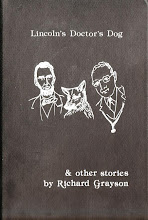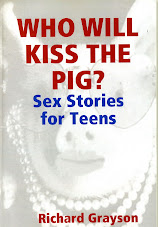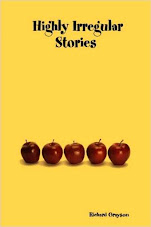Richard Grayson reviews Sexual Metamorphosis: An Anthology of Transsexual Memoirs, edited by Jonathan Ames, in the January/February 2006 issue of American Book Review:
Sexual Metamorphosis: An Anthology of Transsexual Memoirs
Edited and with an introduction by Jonathan Ames
Vintage Books, paper, $13.95, 314 pages
By Richard Grayson
Most Americans are intrigued by transsexuals but don’t know what to make of them. I can recall the dopey reaction of one teenager to the sentimental 1970 film The Christine Jorgensen Story: “She was such a cute guy! Why did she become a girl?”
Sexual Metamorphosis: An Anthology of Transsexual Memoirs, doesn’t answer my adolescent question. Jonathan Ames, the book’s editor, is after something more profound than that. In his introduction, Ames calls the etiology of gender dysphoria “probably unanswerable…a mystery of the human condition.” (xv) The testimony of the fifteen transsexuals compiled here serves as a celebration of that mystery and of the infinity capacity of human beings to reinvent themselves.
At first blush, Ames – a talented novelist, performance artist, and newspaper columnist and perhaps the wittiest writer of his generation – might seem an odd guiding force behind this kind of anthology. But Ames’s comic novels – I Pass Like the Night, The Extra Man, and Wake Up, Sir! – are, at their heart, stories of quirky characters choosing to profoundly transform their lives.
While changing one’s sex may seem like a drastic step, the overarching theme of the entries in Sexual Metamorphosis is restoring the natural order of things. The first excerpt, Case 129 from Richard von Krafft-Ebing’s Psychopathia Sexualis, sets the tone for the volume. A nineteenth-century Hungarian physician describes how, despite marriage and children, he has felt “like a woman in a man’s form” his entire life.
Although the second memoirist, the Danish painter Lili Elbe, born Einar Wegener, died in the 1930s following surgical implantation of ovaries, later medical advances made true sex change possible and fairly safe. At this point, Ames notes, transsexuals’ memoirs take on the same basic narrative structure: First, a child feels terribly uncomfortable in his or her gender role; next, an adolescent or adult, after much torment, undergoes a transformation into his or her “true” sex; finally, after more suffering – now physical as well as psychological – the individual finds peace, if not total happiness, in the aftermath of the sex change.
The excerpts from Jan Morris’s Conundrum – the book that made transsexuals respectable if still a bit outré – exhibit all the stylistic gifts of her best travel writing. Morris’s earliest memory, exquisitely rendered, is of three-year-old James, sitting beneath his mother’s piano as she plays Sibelius, suddenly realizing that he “had been born in the wrong body, and should really be a girl.”
Despite that, Morris relates a happy, nearly idyllic childhood, and seems so well-adjusted that it makes James’s transformation from husband and father into plucky, Mrs. Miniver-like Jan almost anticlimactic.
Some of these selections deal with public reaction to the writer’s metamorphosis. Jorgensen, the former Army private from the Bronx whose Danish sex change operation in 1952 caused a national sensation, is represented here with an account that goes a long way to explain how her unpretentious charm and ladylike demeanor made her something of a beloved figure, the first celebrity transsexual.
In contrast, Christine Cossey, a fashion model and James Bond girl cruelly outed by British tabloids, wanted to keep her gender reassignment a secret, not only to the general public but also to her overbearing mother-in-law. When, to her horror, Cossey’s sex change is revealed, her career and fairy-tale marriage appear to come apart.
Most of these memoirs deal not with public coming out, but with private people struggling with their own feelings and relationships. The excerpt from Deirde McCloskey’s Crossing relates how a distinguished economics professor named Donald, who has long enjoyed dressing as a woman, finally decides to become Deirdre.
McCloskey concentrates on the struggles with Donald’s wife and adult children, who react to his crossing the gender barrier with horror and cruelty. No wonder McCloskey tells her story in the third person.
On the other hand, the excerpt from tennis player and physician Renée Richards’s Second Serve concentrates on the physical aspects of the metamorphosis, recounting in somewhat gruesome detail the bodily pain and suffering she undergoes in her surgical transformation from Richard Raskin, as well as the practical clinical details of maintaining her new sex organs.
A recurring motif is that both rejection and acceptance can come unexpectedly. Donna Rose and Deirdre McCloskey tell of wives who ridicule and demean their husbands’ desires and take extreme measures to avoid them post-surgery and post-divorce. However, the wife of Jennifer Finney Boylan, a novelist and English professor, stays in the relationship after her husband has become a woman.
Generally, transsexuals’ parents and grandparents, even those from the working class, rally around them surprisingly quickly, perhaps because they’ve known something was up since childhood. Children have more trouble getting used to their parents’ transformations, though the younger they are, the more they take the sex change in stride. The funniest moment in the book is when, on his first outing with his newly-female father, Donna Rose’s son Matt, wanting to get her attention in a crowded store, shouts out, “Hey, Dad!” – and immediately covers his mouth as if trying to recapture the words.
As Ames points out, the public is particularly ignorant of female-to-male transsexuals (F-to-M’s). However, the excerpts of the memoirs of Mario Martino, Loren Cameron, and Mark Rees – as well as the account of “Joe” from a book written by Dr. Harry Benjamin, who coined the term transsexual and whose Benjamin Standards are guiding principles that still form the basis for treatment today – show that their struggles are quite similar to their M-to-F counterparts.
One point the anthology makes crystal clear is that sex and gender, sexual orientation and sexual identity, are distinct categories. About the only thing gay and lesbian people have in common with transsexuals, Boylan tells her psychologist, is that the same people beat up both groups.
Uncharacteristically, Jonathan Ames stays in the background too much here. Beyond his thoughtful introduction to the volume, he gives us only a few sentences setting up each entry. A reader unfamiliar with the tragic story of the homophobic murder of Army Sgt. Donald Watkins may be somewhat confused reading the moving excerpts from the memoir of Calpernia Sarah Addams, Watkins’s transsexual beauty-queen girlfriend.
All of the memoirists here are white Americans or western Europeans, leaving readers to wonder how cultural differences might affect transsexuals in other parts of the world. Unfortunately, few Asian transsexuals – the best known are the Beijing Modern Dance Company's artistic director Jin Xing and the Thai boxer-turned-actress Parinya Charoenphol – have written memoirs available in English translation, and as Ames points out, no anthology can be a perfect selection.
However, given their prominence in the transsexual community, the apparent omission of African-Americans is unfortunate. Did Ames deliberately pass on the recent autobiography Hiding My Candy by The Lady Chablis of Midnight in the Garden of Good and Evil fame? Perhaps he felt that her decision to keep her penis – the “candy” of her book’s title – made her different from his other memoirists.
The Lady Chablis may actually be closer in spirit to today’s new trans generation, educated in gender deconstruction and not so interested in becoming a “real” man or women. Forgoing the surgery or even hormone treatments that make the transformation definitive for the writers in Sexual Metamorphosis, young genderqueers can be perfectly comfortable having both breasts and a penis. Loren Cameron, a San Francisco F-to-M photographer, notes in his memoir that younger people have less static gender identification than his generation of transsexuals. Ames, acutely attuned to the cultural scene, is aware of the changes in transsexual culture, but the production of memoirs by the coming generation will have to wait.
Although Ames’s anthology should find a place on the syllabi of college courses in human sexuality, its compelling narratives make Sexual Metamorphosis a work of literature.


































